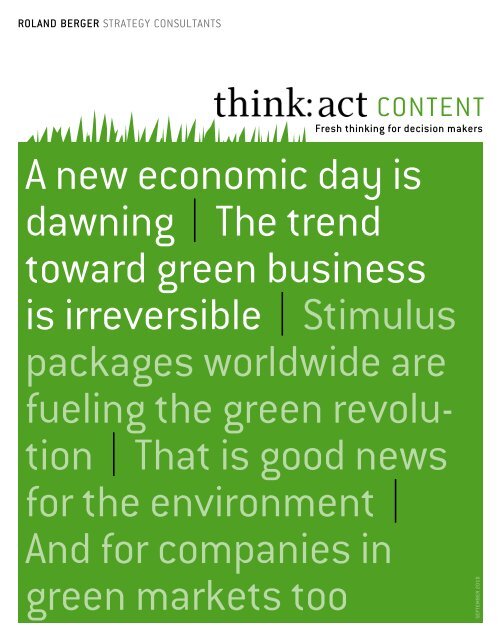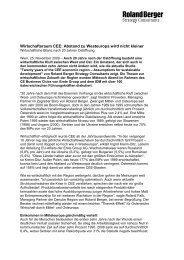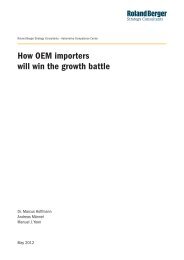A new economic day is dawning | The trend toward green business ...
A new economic day is dawning | The trend toward green business ...
A new economic day is dawning | The trend toward green business ...
Create successful ePaper yourself
Turn your PDF publications into a flip-book with our unique Google optimized e-Paper software.
Roland BeRgeR STrATegy conSulTAnTS<br />
conTenT<br />
Fresh thinking for dec<strong>is</strong>ion makers<br />
A <strong>new</strong> <strong>economic</strong> <strong>day</strong> <strong>is</strong><br />
<strong>dawning</strong> | <strong>The</strong> <strong>trend</strong><br />
<strong>toward</strong> <strong>green</strong> <strong>business</strong><br />
<strong>is</strong> irreversible | Stimulus<br />
packages worldwide are<br />
fueling the <strong>green</strong> revolution<br />
| That <strong>is</strong> good <strong>new</strong>s<br />
for the environment |<br />
And for companies in<br />
<strong>green</strong> markets too<br />
SeptemBeR 2010
... attRaCtS anotHeR dollaR!<br />
tRanSFoRmIng<br />
ConVentIonal BUSIneSS modelS + CReatIng<br />
<strong>new</strong> IndUStRIeS = pRoFItaBle, SUStaInaBle<br />
gRowtH FoR tHe long teRm<br />
ENVIRONMENTAL<br />
TECHNOLOGY<br />
the 21st century's<br />
lead industry<br />
SIX LEAD MARKETS<br />
engines of a <strong>new</strong> industrial<br />
revolution<br />
eVeRY dollaR USed FoR gReen pURpoSeS ...<br />
THE ECO-INDUSTRY<br />
WORLDWIDE<br />
Smart followers hot on<br />
the heels of first movers
As the <strong>economic</strong> cr<strong>is</strong><strong>is</strong> draws to an end, companies in the industrialized world find<br />
themselves facing a twofold challenge. on the one hand, it <strong>is</strong> hoped that restructuring<br />
and cost-cutting programs will shore up their survival and growth in the short term.<br />
on the other hand, the corporate sector <strong>is</strong> itself a key driver of the long-term transformation<br />
of our <strong>economic</strong> and social system.<br />
True, financial, <strong>economic</strong> and national cr<strong>is</strong>es are shaping the course of events right<br />
now. not even profound <strong>economic</strong> turmoil does anything to change the fundamental<br />
challenges that confront to<strong>day</strong>'s world, however. Pollution of the environment, the<br />
population explosion, the growing scarcity of resources even as emerging economies<br />
demand more and more raw materials, the resultant r<strong>is</strong>e in the prices of raw materials,<br />
dwindling biological diversity, the spread of urbanization and demographic change are<br />
all rapidly accelerating the transition in industry. <strong>The</strong> efficient use of energy and raw<br />
materials in particular <strong>is</strong> emerging as a pivotal <strong>is</strong>sue in the battle to preserve prosperity<br />
and keep <strong>business</strong> locations competitive.<br />
climate change clearly ranks among the very biggest challenges. co 2 em<strong>is</strong>sions are<br />
not being reined in fast enough. A voracious appetite for energy and prosperity among<br />
what used to be termed the developing and emerging countries clashes head on with<br />
the shift in values and awareness that <strong>is</strong> gaining ground in more mature economies. <strong>The</strong><br />
copenhagen climate summit may have failed, the uS American clean energy and Security<br />
Act may be dragging its feet, and doubts may be repeatedly ra<strong>is</strong>ed about the reliability<br />
of models forecasting the condition of our planet, but none of th<strong>is</strong> can obscure two<br />
und<strong>is</strong>puted facts: At the very least, the brakes must be put on global warming, and the<br />
unbridled consumption of resources must be cut back drastically if sustainable growth<br />
<strong>is</strong> to continue to underwrite an attractive quality of life and relative prosperity.<br />
We stand at the dawn of a <strong>new</strong> <strong>economic</strong> <strong>day</strong>. <strong>The</strong> critical <strong>is</strong>sues right now are the<br />
development of <strong>new</strong> industries and the transformation of conventional <strong>business</strong><br />
models in order to facilitate profitable growth as a long-term proposition. <strong>The</strong>se two<br />
<strong>is</strong>sues can create competitive advantages, dimin<strong>is</strong>h <strong>economic</strong> and ecological r<strong>is</strong>ks<br />
and safeguard jobs.<br />
governments are doing a fair amount to help. <strong>The</strong> industrialized nations have put together<br />
programs worth billions to promote the development of <strong>new</strong> technologies. <strong>green</strong><br />
industries currently account for a 15% share (approx. uSD 430 billion) of the world's<br />
<strong>economic</strong> stimulus packages. According to calculations made by the International<br />
Monetary Fund, every "dollar used for <strong>green</strong> purposes" attracts another dollar. europe<br />
alone <strong>is</strong> plowing eur 7 billion into energy efficiency – to make cars more <strong>economic</strong>al<br />
and buildings and factories more energy-efficient. eur 6 billion <strong>is</strong> being channeled into<br />
development of re<strong>new</strong>able energies, while eur 3.5 billion has been earmarked for energy<br />
infrastructure. A further half a billion euros will be spent on offshore wind farms. In the<br />
midst of the cr<strong>is</strong><strong>is</strong>, germany has injected some eur 80 billion into the economy, about<br />
13% of which <strong>is</strong> set aside for climate and environmental protection activities. compared<br />
to the international community, that <strong>is</strong> a fairly modest sum. South Korea, for example,<br />
plans to pump around uSD 36 billion – fully 80% of its overall stimulus package – into<br />
megatRend 1<br />
global population in 2010<br />
6.8<br />
BIllIon people<br />
9.0<br />
global population in 2050<br />
BIllIon people<br />
megatRend 2<br />
globalization<br />
megatRend 3<br />
global pursuit of prosperity<br />
Content <strong>green</strong> Business
Roland BeRgeR STrATegy conSulTAnTS<br />
3.1<br />
tRIllIon eURo In SaleS<br />
will be generated by the global <strong>green</strong><br />
industry by 2020<br />
germany's position<br />
in <strong>green</strong> tech<br />
N0. 3<br />
energy efficiency, re<strong>new</strong>able energy and water pollution control over the next four years.<br />
In absolute terms, china <strong>is</strong> spending most (in the context of <strong>economic</strong> stimulus) to protect<br />
the environment and the climate: more than uSD 220 billion – twice as much as the uSA.<br />
As early as 2013, the market for environmental technologies including re<strong>new</strong>able energy<br />
should be worth uSD 1 trillion in the People's republic.<br />
A change in consumer awareness <strong>is</strong> providing welcome impetus for the shifting <strong>trend</strong>.<br />
Buyers expect companies to give them innovative solutions, and ecological criteria in<br />
particular are increasingly influencing purchase dec<strong>is</strong>ions as consumers "shop for a<br />
better world." Scarcely any industry – from automotive to engineering to f<strong>is</strong>hing – can<br />
afford to close its eyes to th<strong>is</strong> <strong>trend</strong>.<br />
"enVIRonmental teCHnologY – tHe 21St CentURY'S lead IndUStRY"<br />
"environmental technology <strong>is</strong> the 21st century's lead industry," says Burkhard Schwenker,<br />
chairman of roland Berger Strategy consultants. H<strong>is</strong> view <strong>is</strong> supported by an exclusive<br />
survey of 1,300 <strong>business</strong>es and 200 research organizations carried out by the company.<br />
<strong>The</strong> key findings make compelling reading. revenues in the global environment industry<br />
will more than double between now and 2020, reaching a level of eur 3,100 billion. <strong>The</strong><br />
environment industry generated revenues of over eur 1,400 billion in 2007, nearly<br />
eur 270 billion of it in germany. re<strong>new</strong>able energy alone gives work to some 300,000<br />
people in th<strong>is</strong> country and 2.3 million people worldwide.<br />
Another recent study by roland Berger Strategy consultants, carried out in collaboration<br />
with the World Wildlife Fund (WWF), puts germany in third place in the world's <strong>green</strong><br />
technology rankings. "<strong>green</strong> tech made in germany" <strong>is</strong> already up among the leaders. <strong>The</strong><br />
country's research effort commands worldwide respect, while its experts boast excellent<br />
qualifications – a healthy point of departure indeed. In forward-looking segments such as<br />
photovoltaics, solar thermal energy, wind power and hydropower, german companies have<br />
global market shares ranging from 21% to 35%. german manufacturers of biogas actually<br />
control 90% of the world's market. <strong>The</strong> country's engineering companies were likew<strong>is</strong>e<br />
quick to spot energy efficiency as an emerging mega<strong>trend</strong>. <strong>The</strong> environment industry<br />
<strong>is</strong> "one of the standard bearers as we anticipate the end of the oil age," in the words of<br />
Deutsche Bank.<br />
coordinated action in many areas <strong>is</strong> needed if germany <strong>is</strong> to fully exploit the potential<br />
afforded by the <strong>green</strong> economy. roland Berger Strategy consultants has conducted<br />
in-depth analyses and studies of the following key questions: How can ex<strong>is</strong>ting competitive<br />
advantages be converted into more growth and <strong>new</strong> jobs? Which thematic<br />
areas in particular lend themselves to th<strong>is</strong> drive? And which markets hold out the<br />
greatest opportunities?<br />
SIx lead maRketS – engIneS oF a <strong>new</strong> IndUStRIal ReVolUtIon<br />
Wind power and photovoltaics are the driving forces behind the lead market for<br />
environmentally friendly power generation and storage. <strong>The</strong> boom in the global wind
power segment <strong>is</strong> continuing unabated in germany. Defying the <strong>economic</strong> cr<strong>is</strong><strong>is</strong>, the<br />
volume of <strong>new</strong>ly installed output rose by 31% year-on-year in 2009. At the same time, the<br />
industry <strong>is</strong> on the verge of a massive structural transition. Whereas pioneering companies<br />
dominated the market in the past, the balance <strong>is</strong> now tipping in favor of major power<br />
utilities – with dramatic consequences for both manufacturers and suppliers. As project<br />
sizes swell, the threat of overcapacity <strong>is</strong> emerging. According to a <strong>new</strong> study by roland<br />
Berger Strategy consultants, consolidation in the industry <strong>is</strong> inevitable. Manufacturers<br />
have no choice but to grow, improve their efficiency and cut their costs. Suppliers, too,<br />
have a lot of adjusting to do.<br />
Between now and 2020, the lead market for energy efficiency will once again double in<br />
size in germany. While th<strong>is</strong> figure indicates only comparatively modest annual growth,<br />
the technologies concerned are already more than ready for the market. Measurement<br />
and control systems and electric motors are fueling most of the current growth. Driven<br />
by biotechnology, the lead market for material efficiency will triple in the same period.<br />
Successful key technologies such as automated separation systems are shaping the lead<br />
market for waste management and recycling. <strong>The</strong>se systems alone could realize annual<br />
growth rates of 15% according to roland Berger Strategy consultants. <strong>The</strong> key driver in th<strong>is</strong><br />
market segment concerns the growing body of worldwide regulations to protect people and<br />
the environment. Through 2020, the lead market for sustainable water management will<br />
expand by a modest 3% per annum. emerging countries in particular will exceed th<strong>is</strong><br />
growth rate as they ramp up and modernize their infrastructure.<br />
<strong>The</strong> transition in the <strong>green</strong> economy <strong>is</strong> clearest in the lead market for sustainable mobility.<br />
To<strong>day</strong>'s market volume will r<strong>is</strong>e from eur 200 billion to around eur 300 billion by 2020.<br />
never before has modern automotive h<strong>is</strong>tory experienced a technological upheaval as<br />
fundamental as the current rapid development in alternative, low-em<strong>is</strong>sion engines.<br />
electric cars are playing a central role here, as are co 2 -neutral fuels. Both areas will have<br />
a formative influence on the future of personal mobility.<br />
e-mobility responds to four mega<strong>trend</strong>s in one: huge growth in the global population and<br />
traffic volumes (in china alone, some 300 million people are on the point of buying their<br />
first car); the imminent collapse of traffic flows in megacities such as Mumbai, Mexico<br />
city and Bangkok (70% to 80% of the world's population will live in cities by 2050); the<br />
need to reduce pollutants and <strong>green</strong>house gases (private cars are currently to blame for<br />
around 7% of the world's co 2 em<strong>is</strong>sions); and our need to come to terms with limited fossil<br />
fuel resources. <strong>The</strong> german government wants to see a million electric vehicles on the<br />
country's roads by 2020. <strong>The</strong> "national electromobility Development Plan" also aims to<br />
establ<strong>is</strong>h germany as the lead market for the relevant technologies. "We must reinvent<br />
the automobile," says Daimler boss Dieter Zetsche. VW ceo Martin Winterkorn <strong>is</strong> clearly<br />
thinking along similar lines: "<strong>The</strong> future of Volkswagen," he says, "<strong>is</strong> <strong>green</strong>."<br />
car producers have no choice in the matter. governments are stepping up the pressure<br />
with ever stricter laws on em<strong>is</strong>sions. In all the major automotive markets, electric cars<br />
will sharply increase their market share thanks to substantial reductions in the cost<br />
of batteries. However, the <strong>new</strong> roland Berger Strategy consultants market study<br />
Content <strong>green</strong> Business<br />
tHe lead maRket FoR<br />
eneRgY eFFICIenCY HaS<br />
ReaCHed matURItY<br />
growth of only<br />
5%<br />
a year<br />
SUStaInaBle moBIlItY<br />
e-mobility <strong>is</strong> a response to four <strong>trend</strong>s
Roland BeRgeR STrATegy conSulTAnTS<br />
SmaRt FolloweRS aRe Hot on<br />
tHe HeelS oF FIRSt moVeRS<br />
gReen patentS gRanted BY tHe<br />
eURopean patent oFFICe, 2007<br />
23%<br />
geRmanY<br />
22%<br />
USa<br />
19%<br />
Japan<br />
"Powertrain 2020: li-ion batteries – the next bubble ahead?" predicts that even those<br />
investment projects that have already been announced will run up significant overcapacity<br />
as early as 2014 to 2017. Th<strong>is</strong> will happen especially in the uSA and Japan. Accordingly,<br />
only six to eight battery manufacturers with a global reach will be able to survive.<br />
consumer acceptance will naturally be critical to the success of electric cars, as buyers<br />
will have to fork out between eur 5,000 and eur 10,000 more per vehicle. That, in the<br />
view of Volkswagen, <strong>is</strong> too much for the majority of car buyers. Manufacturers are thus<br />
already banking on government-backed incentive programs along the lines of the cash<br />
for clunkers scheme.<br />
For the next stage of development, as they prepare electric cars for volume production,<br />
the auto companies are setting their sights on metropolitan regions. For th<strong>is</strong> there are<br />
two reasons. one <strong>is</strong> that urban sprawl <strong>is</strong> already causing personal mobility to strain at<br />
its limits in terms of traffic congestion and air pollution, for example. clean, intelligently<br />
networked vehicles such as the Megacity Vehicle planned by BMW are the obvious solution.<br />
<strong>The</strong> other <strong>is</strong> that it <strong>is</strong> easier to set up the dense network of charging stations that <strong>is</strong> still<br />
ind<strong>is</strong>pensable for electric cars in large cities. In Berlin, for example, rWe has teamed up<br />
with Daimler to launch a pilot project involving 100 electric cars and 500 charging stations.<br />
And it <strong>is</strong> only a matter of time before other car makers and power utilities follow suit. Some<br />
cities themselves are wooing the owners of electric vehicles with special perks. In london,<br />
for instance, electric vehicle users don't have to pay the regular inner-city access charge.<br />
And los Angeles reserves special parking spaces for exceptionally efficient vehicles.<br />
tHe eCo-IndUStRY woRldwIde: SmaRt FolloweRS Hot on tHe<br />
HeelS oF FIRSt moVeRS<br />
Three <strong>trend</strong>s appear to be shaping the face of the <strong>green</strong> industry. <strong>The</strong> first <strong>is</strong> fierce<br />
predatory competition as the first movers are accompanied by smart followers –<br />
companies that intelligently plug into other companies' technological developments.<br />
A willingness to invest heavily in research and development will be critical to the<br />
success of to<strong>day</strong>'s market leaders. <strong>green</strong> technology <strong>is</strong> an extremely innovative<br />
industry characterized by short innovation cycles, so most growth happens when<br />
good ideas are quickly turned into marketable products.<br />
Patents are a good indicator of growth. recent surveys of the environmental technology<br />
industry show that their number rose by about 19% per annum to 1,044 in the period<br />
from 2004 through 2007. german companies lead the field around the world. of all <strong>new</strong><br />
environment-related patents granted by the european Patent office in 2007, 23% came<br />
from germany. <strong>The</strong> uSA (22%) and Japan (19%) followed close behind.<br />
It <strong>is</strong> important to use patents to protect good ideas. Having said that, good ideas only take<br />
on <strong>economic</strong> relevance when they become marketable products and hence part of a value<br />
chain. In the past, german companies have not always been good enough at transforming<br />
r&D into market success. Why? Because the road from basic research to marketable<br />
application <strong>is</strong> often too long. one of the biggest challenges <strong>is</strong> for science and industry to
work closely together – including strategic alliances with the public sector. An outstanding<br />
example of such cooperation <strong>is</strong> the Fraunhofer center for Sustainable energy Systems in<br />
Masdar (Abu Dhabi), the world's first carbon-neutral city. Such approaches ensure that<br />
theoretical research finds its way directly into practical applications.<br />
Second, many environmental technology markets are only now reaching the critical mass<br />
they need to accommodate production on an industrial scale. Fragmentation remains a<br />
conspicuous feature of the environmental technology industry. roland Berger Strategy<br />
consultants believes that waves of consolidation will sweep over the industry in the years<br />
ahead. Th<strong>is</strong> will be the case especially in areas where off-the-peg products enable ever<br />
greater economies of scale. A series of well-resourced companies <strong>is</strong> already exploiting<br />
growth opportunities by means of acqu<strong>is</strong>ition strategies.<br />
Smaller players are under pressure to consolidate. If they fail to make it over the next<br />
technological hurdle, they run the r<strong>is</strong>k of being edged out of the market. <strong>The</strong> fact that<br />
r&D and material sourcing are not really scalable <strong>is</strong> one of the major reasons why<br />
these companies will be forced to explore <strong>new</strong> models of collaboration. otherw<strong>is</strong>e they<br />
could well end up as little more than an extended workbench for the big producers – a<br />
development witnessed years ago in the automotive supply industry.<br />
third, even price-conscious target groups nowa<strong>day</strong>s consider ecological aspects of<br />
consumption when making product purchase dec<strong>is</strong>ions. In the uSA, 30% of consumers<br />
already see themselves as belonging to the "lifestyle of health and sustainability" group,<br />
or loHAS. loHAS like to enjoy life, but only with a good conscience, for which they are more<br />
than happy to pay a dollar or two more. Marketing experts d<strong>is</strong>tingu<strong>is</strong>h between a hard<br />
core of environmentally aware consumers and a wider circle of consumers who vacillate<br />
between buying ecological and non-ecological products depending on the situation. <strong>The</strong><br />
hard core really do want to make the world a better place by shopping <strong>green</strong> and creating<br />
a "demand pull" for more environmentally friendly products. Though not very big in<br />
absolute terms, they form a well-networked community that has a seminal influence<br />
on the image of <strong>green</strong> products.<br />
<strong>The</strong> challenge of reconciling <strong>economic</strong> and ecological interests demands a <strong>new</strong> concept<br />
of progress. In th<strong>is</strong> context, the environmental technology industry <strong>is</strong> emerging as an<br />
extremely dynamic factor. companies in germany can tap vast potential not only in their<br />
domestic market but also in the uSA, Japan, Brazil, russia, India and china. <strong>The</strong> true extent<br />
of th<strong>is</strong> potential <strong>is</strong> revealed by a study comm<strong>is</strong>sioned by the uS chambers of foreign trade.<br />
In collaboration with roland Berger Strategy consultants, they asked 300 companies in the<br />
uS <strong>green</strong>-tech industry – including the uS subsidiaries of a number of german firms – about<br />
their expectations for the future. Some 34% of the uS companies said that they expect<br />
their revenues to grow by more than 10% within the next year and by a further 51% in the<br />
next five years. <strong>The</strong> mood among the subsidiaries of german firms in the uSA was even<br />
more upbeat: 38% expect at least 10% higher revenues in the next year and a further 60%<br />
increase over the next five years. <strong>The</strong> labor market will also benefit: fully 87% of companies<br />
in the study plan to quickly create <strong>new</strong> jobs.<br />
IF YoU HaVe anY FURtHeR QUeStIonS,<br />
we aRe at YoUR SeRVICe anYtIme:<br />
International Green Desk<br />
+49 89 9230-8929<br />
Green_Desk@rolandberger.com<br />
Content <strong>green</strong> Business<br />
gReen gRowtH, gReen pRoFIt<br />
<strong>The</strong> <strong>new</strong> book on "<strong>green</strong> growth" by roland Berger<br />
Strategy consultants will be publ<strong>is</strong>hed in october<br />
in our "think:act" book series!<br />
Green Growth,<br />
Green Profit<br />
manY ConSUmeRS<br />
How Green<br />
Transformation<br />
Boosts<br />
Business<br />
want a clear environmental conscience without<br />
foregoing pleasure!<br />
think:act CONTENT<br />
Editors:<br />
Prof. Dr. Burkhard Schwenker, Dr. Martin C. Wittig<br />
Overall responsibility: Torsten Oltmanns<br />
Project management: Dr. Katherine Nölling<br />
Roland Berger Strategy Consultants GmbH<br />
Am Sandtorkai 41<br />
20457 Hamburg<br />
+49 40 37631-4421<br />
<strong>new</strong>s@rolandberger.com<br />
www.think-act.info
Would you like to get your copy of<br />
think:act CONTENT faster?<br />
Send your e-mail address to us at<br />
global_marketing@de.rolandberger.com<br />
and you will receive the next <strong>is</strong>sue<br />
in advance!

















